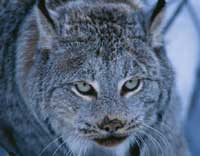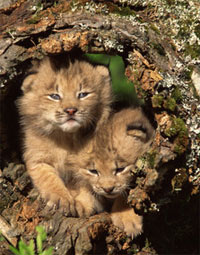|

 Lynxes have short tails, and usually a tuft of hair on the tip of the ears. They have large paws padded for walking on snow, and long whiskers on the face. The color of the body varies from light brown to gray and is occasionally marked with dark brown spots, especially on the limbs. They range about 5 kg or about 11 pounds (roughly the size of a large Domestic cat) up to about 30 kg (66 pounds). The Eurasian lynx is significantly larger than the other species. Lynxes have short tails, and usually a tuft of hair on the tip of the ears. They have large paws padded for walking on snow, and long whiskers on the face. The color of the body varies from light brown to gray and is occasionally marked with dark brown spots, especially on the limbs. They range about 5 kg or about 11 pounds (roughly the size of a large Domestic cat) up to about 30 kg (66 pounds). The Eurasian lynx is significantly larger than the other species.

Habitat: The lynx inhabits the high altitude forests with dense cover of shrubs, reeds and grass. Though the cat hunts only on the ground, it can climb trees and swim. Though it can be found in the northern regions of Scandinavia, it is primarily found in North America and also in pockets in the Himalayas. Since the 1990s there have been numerous efforts to resettle the Eurasian lynx in Germany. It can also be found in Białowieża Forest (northeastern Poland). The critically endangered Iberian lynx lives in southern Spain and (possibly) eastern Portugal.
 Diet: The snowshoe hare is by far the most important prey item for the Canadian lynx. The availability of hares largely controls lynx abundance across most of their range. Other prey species important to lynx are red squirrels, mice, other rodents, and birds. Diet: The snowshoe hare is by far the most important prey item for the Canadian lynx. The availability of hares largely controls lynx abundance across most of their range. Other prey species important to lynx are red squirrels, mice, other rodents, and birds.
Come back!: Starting in 1999, the Colorado Division of Wildlife has begun a program reintroducing a wild lynx population back to the  United States. The animals were trapped in Canada before being brought to the Colorado Rockies, where after being tagged with radio collars frequently migrated throughout the western United States. While showing early signs of promise, biologists say it will take more than a decade to determine whether the program is a success. United States. The animals were trapped in Canada before being brought to the Colorado Rockies, where after being tagged with radio collars frequently migrated throughout the western United States. While showing early signs of promise, biologists say it will take more than a decade to determine whether the program is a success.
Loner: The lynx is usually solitary, although a group of cats can travel and hunt together. Mating takes place in the late winter. Its desired resting place is in crevices or under ledges, and it gives birth to 2 to 4 kittens at a time. It feeds on birds and mammals and often on sheep and goats. lynx (spotted) have been observed (2006) in the Wet Mountains of Colorado.
All text is available under the terms
of the GNU Free Documentation License
|
